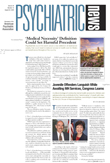Anxiety disorders appear to be underdiagnosed and undertreated in routine psychiatric practice, according to a study reported at the 2004 AcademyHealth meeting in San Diego.
The prevalence of anxiety disorders—phobia, generalized anxiety disorder, posttraumatic stress disorder (PTSD), and panic—among patients of a subset of psychiatrists in the American Psychiatric Institute for Research and Education's (APIRE) Practice Research Network was much lower than the prevalence among patients in the National Comorbidity Survey (NCS) who had seen a psychiatrist or mental health professional in the previous month.
The difference appears to be largely explained by the fact that patients in the NCS sample were given a very detailed, structured interview specifically designed to identify and diagnose all manner of psychiatric disorders.
Phobias were 22 times more likely to be diagnosed in the NCS sample compared with the patients of psychiatrists in the Practice Research Network. In the NCS sample, PTSD was diagnosed five times more often, generalized anxiety disorder was diagnosed more than three times as often, and panic disorder was diagnosed more than twice as often.
Study co-author Darrel Regier, M.D., M.P.H, told Psychiatric News that previous research had already indicated that anxiety disorders are much more prevalent than is generally reflected in clinical interviews by psychiatrists.
He noted that patients in the NCS sample were interviewed using highly structured interview instruments. In contrast, psychiatrists working in a“ real-world” environment may rely on clinical impressions formed from often all-too-brief encounters with patients.
Anxiety disorders are often liable to coexist with other mental disorders that may be more prominent and be the focus of diagnosis and treatment.
“The clinician will home in on what appears to be the patient's chief complaint and may go through several visits and never realize that in addition to substance abuse or schizophrenia or depression, the patient also has a significant anxiety component contributing to the level of severity,” he said. “If the clinician thinks depression is more significant than anxiety, that is likely what the clinician will report.”
Regier is executive director of APIRE and director of APA's Division of Research.
Understanding How Symptoms Aggregate
In the study, cross-sectional data were analyzed from the 1997 and 1999 Study of Psychiatric Patients and Treatments (SPPT), which looked at practice patterns among a subset of psychiatrists in APIRE's Practice Research Network. These psychiatrists represented a full range of inpatient and outpatient clinical settings.
Each participating psychiatrist was randomly assigned a start time and date and asked to complete a patient log for the next 12 consecutive patients for whom face-to-face treatment was provided. Participants then were asked to provide clinically detailed data on three randomly preselected patients from the patient log.
A total of 754 psychiatrists provided information for analysis on 2,117 patients aged 15 to 54 who had at least one diagnosis. These data were compared with data from structured interviews with 154 respondents from the NCS sample who had been treated or evaluated for a disorder by a specialty mental health or addictions professionals—psychologist, psychiatrist, or social worker—in the previous month. Moreover, some of the patients in the psychiatric sample who were diagnosed with anxiety disorders may not have been receiving treatment, according to the study. More than 10 percent of patients with panic disorder were receiving neither psychotherapy nor antianxiety medication (including SSRIs), while 14 percent of patients with no anxiety diagnosis but moderate to severe anxiety symptoms were not receiving psychotherapy or antianxiety medication.
More than 75 percent of patients with generalized anxiety disorder or panic disorder in the PRN sample were receiving antianxiety medications, while less than two-thirds of patients with a phobia diagnosis were receiving these medications. The most commonly prescribed antianxiety medications included alprazolam (16.7 percent of patients with anxiety disorders), clonazepam (16.4 percent), and paroxetine (15.9 percent), according to the study.
Implications of Findings
Regier said that beyond the immediate clinical implications, the findings contribute to an understanding of how symptoms naturally aggregate in patients, an insight useful for future diagnostic classifications.
“If you can define your patients by the full range of symptoms they have instead of just focusing on the major complaints, you have a better chance of understanding how these symptoms come together in nature in a normal population,” he told Psychiatric News. “Then you have information that can feed back into a revision of DSM.”
Regier noted, for instance, that recent research indicates that generalized anxiety disorder and major depression occur in a common genetic pool and that environmental influences after conception are likely to determine how the genetic predisposition will be expressed, as anxiety or as depression.
“It is important to track the distribution of anxiety and depression and other symptoms for the purpose of trying to understand the underlying pathophysiology,” Regier said. “That is what we are trying to get at ultimately to improve treatment.” ▪
